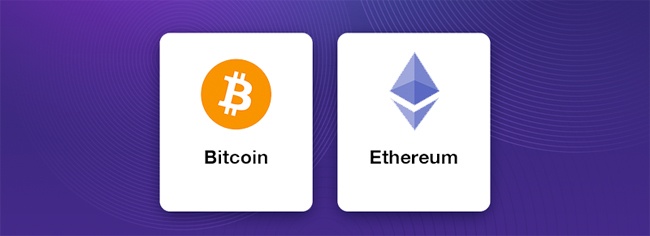This question may come up in many a discussion with newbies entering the cryptocurrency domain, but surprisingly, even some who have been in the cryptocurrency field for a while may still have some confusion as to the strengths of the individual coins.
The question above can bring about a look of bewilderment on the faces of some, while others answer the question with a sense of elderly wisdom, telling young grasshoppers that Bitcoin is to an apple what Ethereum is to an orange. The two are playing in different dimensions.
This extensive comparison is meant to provide a sense of clarity on the matter of the differentiation between the two prominent cryptocurrencies, Ethereum and Bitcoin.
Let’s Start With the Basics – What is Bitcoin Anyway?

Image credits:
Bitcoin is the world’s first cryptocurrency. The currency was developed and released in 2009 by Satoshi Nakamoto – an unknown and secret entity that has yet to reveal itself to the general public.
Some say that Satoshi Nakamoto is one individual, while others think that this is an elusive collection of individuals; the truth is, no one definitively knows.
This sense of enigma has only added to Bitcoin’s aura of mystery, and it continues doing so to this very day. However, this sense of mystery and anonymity certainly did not stop Bitcoin from being a famous technological innovation.
Bitcoin was created on its own open-source software network, which was built upon the then-new technology called “blockchain”. Therefore, Bitcoin does not only refer to the cryptocurrency (BTC) itself, but also to its decentralized payment network.
According to the Bitcoin whitepaper, which described at the time how the invention will work, the digital coin was meant to act as “electronic cash” without any physical representation of the currency.
The aim for Bitcoin was for anyone to be able to use it to receive and send money all over the world through the network’s highly secure yet transparent ledger functionalities.
By doing this, Bitcoin was to revolutionize the way money was transacted globally, without the control of governments or financial institutions.
All that people had to do in order to make a transaction was to buy or earn Bitcoins and send them to another user of their choice on the network. The sender was to pay a transaction fee, and the transaction was to be completed within minutes – all without disclosing personal information to anyone, even to individuals on the network.
This aim is somewhat achieved by Bitcoin in its current state. Bitcoin is slowly becoming a prominent method of payment between people who prefer privacy without the restrictions of borders.
The fact that Bitcoin’s network was also completely decentralized was one of the core factors why Bitcoin gained significant adoption. Being decentralized simply meant that the network was not controlled by any single entity, meaning that anyone, anywhere could join and contribute to the network.

Image credits:
The blockchain technology on which Bitcoin operated was also one of the reasons why it was so sought after. The blockchain provided immense security enhancements that could not necessarily be found in established protocols and systems.
The information and coins stored on the blockchain network were cryptographically secured, with transaction statistics also being recorded as immutable information to ensure transparency.
As noted above, blockchain technology and economic design also provided immense security against hacking attempts.This is why the Bitcoin network is not significantly susceptible to hacks.
With these features, Bitcoin slowly grew to be adopted by people outside of the technology sector. After a few scandal-ridden use cases by people who used Bitcoin’s privacy and security features for illicit means, the cryptocurrency slowly made its way to mainstream adoption, and that brought it to be known as the Bitcoin that we all know today.
Phew, That Was Long. Okay, What is Ethereum?
Ethereum, like Bitcoin, is also an open source, decentralized software network that is based on blockchain technology. In contrast to Bitcoin, Ethereum was co-created by a known individual, Vitalik Buterin, a Russian-Canadian developer.
Following Buterin’s proposal in 2013 to create a blockchain network with a scripting language to supplement additional development capabilities, Ethereum was developed and released in 2015.
The network itself is named Ethereum, while its cryptocurrency is called “Ether” (ETH). However, it typically is referred to as Ethereum for the sake of simplicity.
The cryptocurrency has similar operations to that of Bitcoin. Ethereum also has a currency that can be sent and received globally, it remains secure, and the record of transactions remains transparent.
But unlike Bitcoin, Ethereum is not just a blockchain network that solely runs a cryptocurrency’s operations. Ethereum is not supposed to be an electronic cash peer to peer system. Ethereum has a different vision, it seeks to become a virtual machine or a development environment.

Image credits:
Yes, by using the Ethereum network, other developers can create their own applications. Developers can actually create and deploy their own decentralized applications, smart contracts as well as their own cryptocurrencies, referred to as Ethereum or ERC20 tokens.
These functions along with additional features are supported through one of Ethereum’s core functions, called “Smart Contracts” (an evolved part of the scripting language that Buterin initially proposed).
However, Ethereum does not restrict developers to simply creating new cryptocurrencies. The possibilities that Ethereum offers through its smart contracts are also utilized by non-financial organizations who want to leverage blockchain technology security and transparency in their various operations.
All of this is made possible by the Ethereum platform and its capability to supplement these functions through its developer-friendly “Ethereum Virtual Machine” (EVM). While developing their own operations through the EVM, developers use the Ethers (ETH) as “Gas” to pay for computational costs.
This marks a primary use for Ether (ETH) to be utilized as something other than a primary cryptocurrency.
The Difference Between Bitcoin and Ethereum

Image credits:
As explained by the factors above, it would be clear by now that the stark difference in Bitcoin and Ethereum come from their visions and operations.
Bitcoin is to serve as a peer-to-peer (P2P) electronic cash system, while Ethereum is to serve as a virtual environment that will allow development of a variety of interesting features.
It is also important to note that Bitcoin is still finding its way in being a superior peer-to-peer electronic cash system, and due to the way that Ethereum has been technically structured, it can perform transactions relatively faster than the Bitcoin network.
But, if you are thinking that this makes Ethereum “better” than Bitcoin, please, hodl your horses. It is important to note that there are quite a few other factors at play here too.
Both platforms have faced scalability issues and are working on potential implementations like the Lightning Network for Bitcoin and the Casper Update for Ethereum.
Another significant point of differentiation comes in their respective approaches to monetary policy. Bitcoin has a set cap of 21 million coins that will ever be in existence, Ethereum does not have a cap on currency.
Which leads us to another point.
If a value is derived from demand and supply, as long as there is demand for Bitcoin, Bitcoin should have a higher price than Ether. again, this is so because Bitcoin supply is limited while Ether supply is continuously increasing.
Which leads to another conclusion.
Bitcoin is seen as a store of value asset and digital gold. While Ether acts as a utility, will have continuous inflation (even if the rate of inflation is set to decrease per year) and serves as digital oil, serving the purpose of being fuel for the Ethereum platform.
Bitcoin can serve as a store of value, means of payment, and as an unit of account. This leads to the point of perception. Bitcoin is currently seen as digital gold, is seen as an asset that one would use to hedge against volatility in the fiat system, say economic turmoil and strife. As more subscribe to the idea that Bitcoin is digital gold, it becomes more relevant from a global standpoint.
Its perception is comprised of its history, longevity and being the first ever cryptocurrency of the world. Being the originator of money the blockchain also works in Bitcoin’s favor, when it is not facing the issues of slower transaction times, it works toward the purpose of being “electronic cash”.
Bitcoin is also known as the inspiration for all the cryptocurrencies and blockchain networks that we now see being deployed on a regular basis, including Ethereum.
Consensus Algorithm for Bitcoin and Ethereum

Both networks use a similar algorithm for verifying transactions. As mentioned above, while the networks are decentralized, people can join to help run their functions and get paid by the system in return. Here’s how that works.
When a new transaction request is submitted by any user on the network, the people or rather, their computers, start processing the transaction. There is a sense of competition present since no matter how many computers start working on the same block simultaneously, the one who solves the puzzle first is credited as the sole validator of the transactions in the block.
In order to process the transaction, computers have to solve mathematical, cryptographic puzzles in order to prove to the system that the transaction was validated.
That, in turn, helps in minting or “mining” new coins. The system then rewards the newly created coins to the individual who solved the puzzle first. This is done to ensure that new coins are not created by the means of spamming but only through proper efforts. Think of this as the “captcha” for blockchain.
This process is referred to as mining and the people who validate the transactions are called “miners”, due to how they are participating in mining new coins like gold.
Furthermore, the transaction validation procedure is called “proof-of-work” (PoW), which is the network consensus on validating transactions. Both Bitcoin and Ethereum use this PoW consensus for now, but Ethereum will soon switch to a different consensus model called “proof-of-stake” (PoS).
When implemented, the Ethereum PoS will work by randomly selecting individuals out of a pre-designated pool. Once a person is selected, they will automatically perform the necessary activities to verify the transaction.
This switch should allow for increased speed in processing transactions and more. The switch to PoS should also allow for the reduction of the unprecedented electricity usage (a major issue on these two networks), due to rigorous mining activities fueled by competitiveness consuming a lot of power.
Additional Points on Whether Bitcoin or Ethereum is Better Than The Other

Image credits:
Where Bitcoin lacks in additional features, it makes up by backing itself with age, higher value, and worldwide recognition due to being synonymous with the word “cryptocurrency”.
Whereas, Ethereum brings additional features to the table for its lack of the aforementioned distinctions, and serves a different primary purpose than Bitcoin.
Where Bitcoin opened doors to new cryptocurrencies by offering its open source technology to developers, Ethereum did the same with its platform by offering developers the ability to create new tokens through it, essentially giving birth to the trend of initial coin offerings (ICOS), the crowdfunding mechanism that took the world by storm in late 2017.
For every improvement that Bitcoin presents (such as Lightning Network or SegWit), Ethereum provides its own prepared answer in the form of development centric functionalities (think of the Raiden Network or Sharding).
This works both ways. As mentioned above, for every innovation that Ethereum brings to the table as a development platform, Bitcoin has its own solutions for being a platform which is completely and solely focused on making its high-valued cryptocurrency more usable.
And that is where the “apples and oranges” analogy comes in. If you compare Bitcoin, a cryptocurrency or payment platform; and Ethereum, a development platform that has its own cryptocurrency: you are certainly making the comparison in an unbalanced setting.

Image credits:
Both of these cryptocurrencies and their platforms are meant to deliver different primary objectives, and they come with their own set of challenges.
- Bitcoin aims to be electronic cash while currently serving as the equivalent of digital gold: a cryptocurrency that can be transacted easily and could also be held as an investment when people want to “save”.
- Ethereum wants to be a primary development platform: a developmental solution for decentralized applications, new cryptocurrencies, their platforms and their launch events of ICOs. The Ethereum network struggles with scalability issues while trying to meet these requirements, but like Bitcoin’s troubles with value, these too should get resolved in the future.
This goes to show that it’s not just their primary objectives at present are different, but their future goals too, that differ greatly from each other. While people could try pitting them against each other, these platforms actually aim to serve completely different purposes in the long run.
Therefore, people could try comparing them all they want, but a fair comparison could only happen if these cryptocurrencies were playing on a level field.
Look at it like this: think of Bitcoin as a football team and Ethereum as a baseball team. No matter how proficient each of them is in their respective sports, comparing them would seem absurd.
Just like many other comparisons in the world, there is no definitive answer here and the matter of the “better” cryptocurrency remains that of perspective alone.
“Apples to oranges” indeed.
Don’t forget to also check out our Bitcoin vs Bitcoin Cash guide.
Featured image
